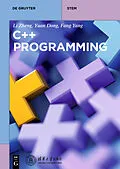This book begins by explaining key concepts in programming, and elaborates on characteristic of class, including inheritance, derivation and polymorphism. It also introduces generic programming and Standard Template Library, I/O Stream Library and Exception Handling. The concepts and methods are illustrated via examples step by step, making the book an essential reading for beginners to C++ programming.
Autorentext
Li Zheng, Tsinghua University, Beijing, China
Inhalt
Chapter 1 Introduction1. 1 The Development of Computer Programming Language1.2 Object-oriented Method1.3 Object-oriented Software Development1.4 Representation and Storage of Information1.5 The Development Process of ProgramsSummaryExercisesChapter 2 Elementary C++ Programming2.1 An Overview of C++ Language2.2 Basic Data Types and Expressions2.3 Data Input and Output2.4 The Fundamental Control Structures of Algorithms2.5 User-Defined Data TypeSummaryExercisesChapter 3 Functions3.1 Definition and Use of Function3.2 Inline Functions3.3 Default Formal Parameters in Functions3.4 Function Overloading3.5 Using C++ System FunctionsSummaryExercisesChapter 4 Class and Object4.1 Basic Features of Object-Oriented Design4.2 Class and Object4.3 Constructor and Destructor4.4 Combination of Classes4.5 UML4.6 Example - Personnel Information Management ProgrammeSummaryExercisesChapter 5 Data Sharing and Protecting5.1 Scope and Visibility of Identifiers5.2 Lifetime of Object5.3 Static Members of Class5.4 Friend of Class5.4 Protection of Shared Data5.6 Multi-file Structure and Compilation Preprocessing Directives5.7 Example - Personnel Information Management ProgrammeSummaryExercisesChapter 6 Arrays, Pointers and Strings6.1 Arrays6.2 Pointers6.3 Dynamic memory Allocation6.4 Deep Copy and Shallow Copy6.5 Strings6.6 Example - Personnel Information Management ProgrammeSummaryExercisesChapter 7 Inheritance and Derivation7.1 Inheritance and Derivation of Class7.2 Access Control7.3 Type Compatible Rule7.4 Constructor and Destructor of Derived Class7.5 Identification and Access of Derived-Class Member7.6 Example - Solving Linear equation by Gaussian Elimination MethodSummaryExercisesChapter 8 Polymorphism8.1 An Overview of Polymorphism8.2 Operator Overload8.3 Virtual Function8.4 Abstract Class8.5 Example - Variable Stepwise Trapezoid Method to Calculate Functional Definite Integral8.6 Example - Improvement to Staff Information Management System in a Small CooperationSummaryExercisesChapter 9 Collections and Their Organization9.1 Function Template and Class Template9.2 Linear Collection9.3 Organizing Data in Linear Collection9.4 Application - Improving the HR Management Programme in a Small CooperationSummaryExercisesChapter 10 Generic Programming and STL10.1 Generic Programming10.2 Containers in STL10.3 Iterators10.4 Algorithms in STL10.5 Function Objects10.6 Application - Improving the HR Management Programme in a Small CooperationSummaryExercisesChapter 11 The I/O Stream Library and Input/Output11.1 the Concept of I/O Stream and the Structure of Stream Library11.2 Output Stream11.3 Input Stream11.4 Input/Output Stream11.5 Example - Improving Employee Information Management SystemSummaryExercisesChapter 12 Exception Handling12.1 Basic Concept of Exception Handling12.2 Implementation of Exception Handling in C++12.3 Destruction and Construction in Exception Handling12.4 Exception Handling of Standard Library12.5 Example - Improvement to Personal Information Administration Programme in a Small CooperationSummaryExercises
